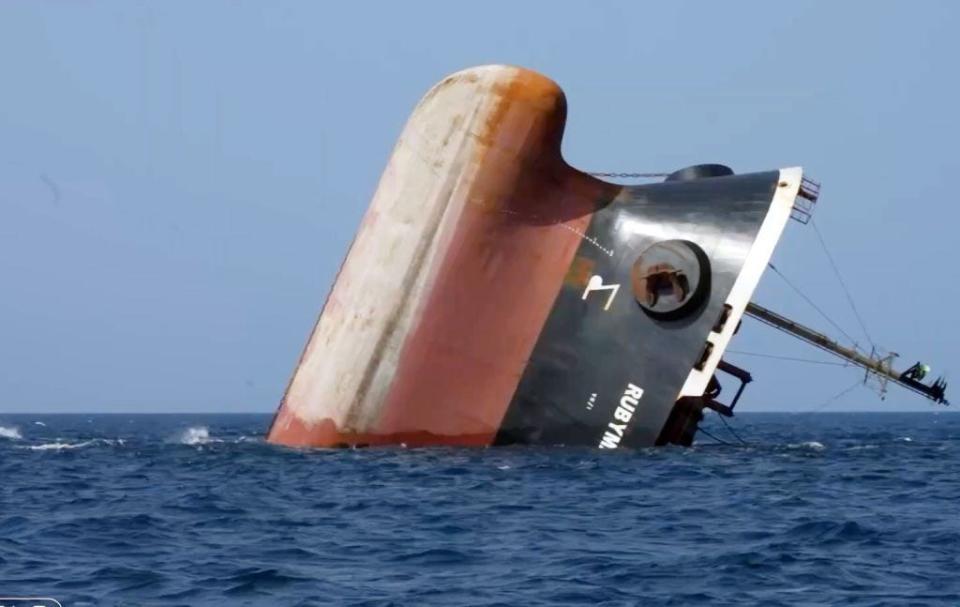Yemen's Houthi rebels are menacing ships on the high seas
Commercial ships have diverted from the Red Sea over the Houthi missile threats.
The Houthis showed in late April they can strike ships in the Indian Ocean.
"By disrupting shipping, the Houthis can impose costs on the global economy," a naval expert said.
Houthi militants showed in late April that they can expand their war on international shipping far beyond the Red Sea.
The container ship MSC Orion came under a drone attack on the night of April 26 as it was steaming in the Indian Ocean southeast of the Horn of Africa, the continent's eastern-most tip. The attack only caused minor damage and did not harm any crew. But the distance involved was unprecedented.
The Houthis have wreaked havoc against international shipping in the Red Sea with ballistic missiles and exploding drones, and threatened in March they could menace ships that avoided this route by going around Africa's southern Cape of Good Hope, a much longer and more expensive voyage.
"The Houthis have drones that can travel more than 1,000 nautical miles, such as the Shahed series of propellor-driven drones," Bryan Clark, a senior fellow at the Hudson Institute and expert on naval operations, told Business Insider. "Their ballistic missiles have ranges of more than 600 [nautical miles]."
The long-range attack on the Orion appears to have been a one-off but is still unprecedented, an expert on drone warfare said.
"The attack was different in the fact it was achieved over a greater distance than previous attacks on international shipping," James Patton Rogers, the executive director of the Cornell Tech Policy Institute, told Business Insider. "This shows advances in range, command and control, and accuracy, all of which are occurring despite US-UK efforts to degrade the group."
Rogers believes the Houthis may have used a long-range Shehab drone in the attack.
"Until now, the Shehab drones have proven vulnerable to air defense and unreliable," Rogers said. "As such, if Shehab drones were used in the strikes, which the video evidence appears to show, then it would mark an increase in the reliability and destructive precision of these drone systems."
He noted that the Shehab's reported range of 990 miles puts it "well within range" of international shipping. The US and EU have stood up naval task forces to guard ships in the Red Sea, but merchant ships far outside of these air defense umbrellas have no defense against an attack drone.
"Yet these are not the only systems available to the so-called' axis of resistance' groups," Rogers said. "The Samad (1500km/932 miles) and potentially the Shahed (2000km) family of drones all have the range to strike these targets."

Searching and targeting ships in international waters is also another escalation from the group's attacks near the Red Sea. The Houthis are most likely exploiting the self-reporting of merchant ships to target them.
"The Houthis appear to be using AIS (Automatic Identification System) data to geolocate their targets and use GPS to guide their drone to the approximate area," Clark said. "Reportedly, drones like the Shahed series have anti-radiation seekers they can use to drive into emitting targets like air defense radars."
The Orion stopped transmitting its AIS after the April 26 attack, likely to prevent the Houthis from tracking the ship for a second strike. Clark also believes ships like the Orion may opt for "going dark" for segments of their voyage to avoid being tracked. Ships smuggling Russian oil have done this since the start of the current Ukraine war in 2022.
There are some ways these ships can evade such attacks or, if necessary, physically fend them off.
"They could turn off their AIS and radar, which would make them hard to find in the open ocean of the Eastern Mediterranean," Clark said. "Once they enter the Red Sea, though, ships can be tracked by spotters ashore or on boats or using mobile Houthi radars ashore. In that case, shotguns or high-power microwave counter-drone weapons would be needed."
Ships may opt for alternative or longer routes to avoid these attacks, and while this may reduce the number of attacks, that would also have a disruptive impact on shipping of the kind the Houthis would welcome.
"The easiest, although more expensive, way to address this threat is to avoid it," Clark said. "Unfortunately, that is what the Houthis want. By disrupting shipping, the Houthis can impose costs on the global economy and put pressure on Israel."
US forces targeting the Houthis in February encountered an undersea drone for the first time and successfully struck it.
"There are few details about the Houthi's underwater drone capacity, but what there is suggests the drones are slow-moving and more useful against stationary targets, ships vulnerable in dock," Rogers said. "Nevertheless, with the rate of Houthi advances, and increases in speed, control, and maneuverability in-transit, international shipping could soon prove vulnerable."
Clark doesn't see undersea drones posing much of a threat to ships on the high seas.
"Undersea drones are really only a threat in narrow waters like the Red Sea where the range to shore is short," Clark said. "Undersea drones can only travel a few knots and therefore cannot catch up to a cargo ship. The drone has to intercept the target, which requires knowing where the target is going, such as in a narrow waterway."
Rogers believes the broader implications of the Orion attack are already clear.
"Violent non-state groups are not only able to strike shipping hundreds of miles from shore, but they are able to pass this technology on to other groups allied with the cause or willing to pay a price," Rogers said.
"In essence, we have reached a stage where the proliferation of this capacity is uncontrolled and unchecked, potentially bringing international shipping and global supply chains under increased threat globally."
Read the original article on Business Insider

